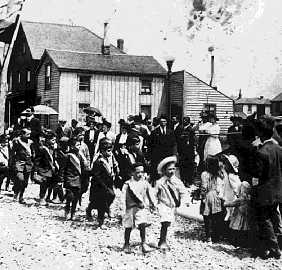![[Industrial Trail Logo]](logosmall.jpg) MADE
IN HAMILTON
MADE
IN HAMILTON20TH CENTURY
INDUSTRIAL TRAIL
![[Industrial Trail Logo]](logosmall.jpg) MADE
IN HAMILTON
MADE
IN HAMILTON
20TH CENTURY
INDUSTRIAL TRAIL
SITE
24
A
NEW LIFE
 In
1900, Hamilton's population was still predominately British. Within years, however,
many workers from southern and eastern European countries had come to work in
the city. Newcomers often did the hottest, heaviest and dirtiest work in the
new east end mills. Members of the same ethnic group often found work at the
same plant - Italians in Stelco's blast furnaces, Armenians in International
Harvester's foundries, for example.
In
1900, Hamilton's population was still predominately British. Within years, however,
many workers from southern and eastern European countries had come to work in
the city. Newcomers often did the hottest, heaviest and dirtiest work in the
new east end mills. Members of the same ethnic group often found work at the
same plant - Italians in Stelco's blast furnaces, Armenians in International
Harvester's foundries, for example.
Many male migrant workers came to Hamilton every year to earn money for their families back home. As time went on, many decided to stay, often saving for years to bring over family members. These families formed close-knit communities. To be close to work, many immigrants lived in the neighbourhoods north of Barton Street on either side of Sherman Avenue. The diversity of backgrounds is evident today in the multi-ethnic mix of businesses along Barton Street.
Institutions such as the church of St. Stanislaus Kostka, built by the Polish community, reflect the vitality Hamilton's newcomers brought to their new home. Construction of the church began in 1912. Polish workers employed in factories nearby committed a portion of each pay check to help finance the project. They did much of the building themselves.